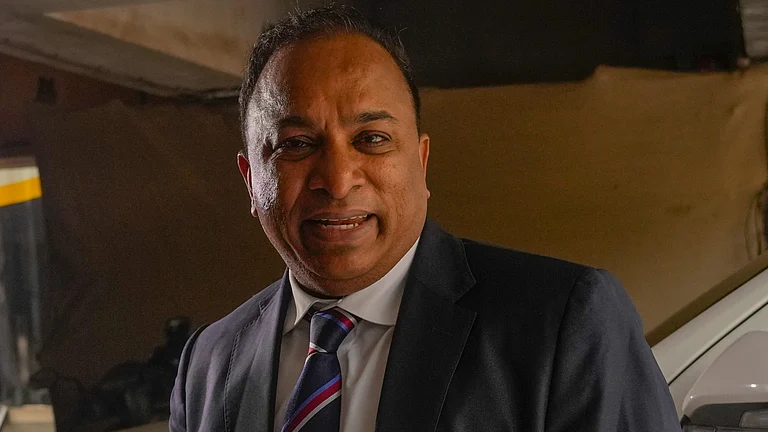
Though differing in their emphases, all these stories of India shared a romantic and expressivist view. They choose to see India's multitudinousness as an expression or emanation of some singular spirit, essence, or idea. Empirical, ever-visible differences were simply manifestations of inner, deeper commonalities, individual Indians were vehicles for an abstract Indianness. Needless to say, such romanticism was often little more than a direct and irritated riposte to the British answer to the Indian puzzle, which insisted that India possessed no internal unity, but was merely an assemblage of castes, tribes, races, religions, languages, artifacts, stories that had to be held together by an external political power. English nominalism begot Indian essentialism.
Today, we find ourselves once more in the throes of questions and doubts about what is Indian. The subject excites and anguishes us. Our current quarrels echo many of the ideas as well as the vocabulary of that earlier period, yet they are murkier and less illuminating. We seem afflicted by what some, writing of parallel soul-searchings in Ireland, have diagnosed as an 'over-identity' crisis—a fascination with self-definition that verges on an erotic thrill, a sexual frisson that delivers a tingling uprightness. What lies behind this new erotics of identity, why has it come about?
After all, one might have assumed that the problem of Indianness was resolved by the creation of an Indian state in 1947. Since that date, India has existed as a specified territory: as the space that, as Salman Rushdie once put it, keeps Pakistan and Bangladesh apart (as it does, for that matter, Tibet and Sri Lanka). That territory belongs to the Indian state, which is entitled to decide and to enforce whether this or that tree, mountain, cow or person, is or is not Indian. Our bounded land was defined by a modern-day version of the Asvamedha, the Boundary Commissions of Cyril Radcliffe; as well as by subsequent wars and skirmishes to maintain or modify these boundaries. There is, in this sense, a juridical clarity to the question of 'what is Indian?', clarity of a kind that simply could not have existed prior to the establishment of an Indian state. And yet, there is nothing distinctively Indian about this aspect of Indian identity. To become fixated on borders and on the ability to guard what resides within them, to see this as somehow definitive of Indian identity is to mistake what is a universal requirement of every state (the Pakistani state too, after all, is compelled to do its duty in this respect) for a distinctive feature of Indianness. Indianness can hardly rest in this.
The pressing and persistent problem since 1947 has been that of trying to take the many stories and ideas of India put abroad in the first half of the century and make them fit with the actual physical space of India, and with the people who live within it. It became the state's task to try to accomplish this fit. But, over the past 50 years, those responsible for the actions of the Indian state have used its powers to hugely varying effects—allowing, at different times, different stories and ideas of Indianness to direct the doings of the state. It's an important point to register—because, in a democratic society, different stories can and surely will rise up to the surface, as different groups seek to appropriate for themselves the coercive powers of the modern state. Some may choose to use these powers minimally and defensively; others may choose to use them more fulsomely and aggressively.

Consider our Consider our own recent history. In the '50s and '60s, those in charge of the state did indeed seek to implant a certain idea of India. They did this in various ways—by politics, by development, and of course also by attempted indoctrination. This was accomplished both by daily reminders—Akashvani, with its bulletins and music programmes—and by annual spectacle: such pantomimes as the Republic Day parades, where India was presented as a pageant of composed and ordered differences. The epic, lyrical poetry of earlier imaginings of India was transcribed into the bureaucratic prose of building a 'composite India'.
And yet, during these years, this was never a monolithic or all-encompassing project. For several decades after independence, there remained significant space for a various Indianness to flourish. Throughout these years, the presence of the state may have loomed large in many areas, especially in the economy; and it may well have produced only a superficial veneer of Indianness, of a 'national' culture, by pursuing methods that in retrospect look naive. But there was one very important feature of the project of defining Indianness during this period that bears recall. The state did not try to impose a uniform definition of a national culture, it did not molest local loyalties—although it did frequently try to persuade such loyalties to adopt wider horizons. It respected the element of choice—for religions, regions, languages and above all for individuals—in deciding the issue of how to be Indian. And it recognised that its citizens might choose to maintain simultaneous allegiances to a variety of things: nation, region, religion, language—such loyalties were not seen as necessarily competitive or exclusive identities.
This achievement can be better appreciated by noticing two senses implicit in that long-suffering, much over-used phrase, 'a composite culture'. This can mean a culture spatch-cocked together from different contexts: designed to produce 'one nation, one people, one culture'—the promise of the bjp manifesto. The result in this case is like one of those 'exquisite corpses' that children so love to draw—where each child completes one part of a body, without knowing what the other has drawn, thereby producing a beast at once grotesque and hilarious. Or one might understand a composite culture to mean that there isn't any single body, no singular image or snapshot that can be held up as a cultural norm. Instead, all there is is an album or portfolio of images, across which there runs a family resemblance. Thus, one might recognise a jawline, a twist to the smile, a look in the eyes; but each individual is singular, itself—and not the mongoloid product of some strange and coerced coupling.
What lurks behind our current eroticisation of identity are, I think, two broad processes, unevenly matched and actually in contradiction with one another, that together are creating the conditions for our convulsive fascination. First, we see today a political movement devoted to completing what it views as the unfinished project of creating an Indian state in the image of a Western one. It wishes to connect one particular and exclusive story of what India is with the coercive powers of the state.

The leaders and ideologues of this movement are committed to a view that allegiances of belief and culture are fundamentally competitive and exclusive. They cultivate a voice that moves easily across various, quite opposing, registers: it basks in the pleasures of victimhood and exploits the opportunities for resentment, while proclaiming a demand for vengeance and declaring its own omnipotence.Indianness, in this story of what is Indian, has been narrowed to mean a simplified version of religion, presented as choiceless fate, as a destiny that must be fulfilled—and whose chosen vehicle of fulfilment is the modern state, complete with nuclear warhead.
Religious nationalists are in love not so much with religion, but with the modern state and its armoury. The daemon that keeps the Hindu nationalist awake at night is the fear that they live within what they describe as the 'soft state'—a state that looks too little like a Western one and too much like, well, precisely, an Indian one. 'One Nation, one culture, one people', remember? India, frustratingly, is not like this; let us beat it into shape. This is a yearning to conjure a culturally and ethnically cleaned up homogeneous community, one that possesses a singular Indian selfhood, defended to death by a ill-muscled state. It is a desire to make us into an acceptably tidy, if somewhat cheaper, suburb nation-state, at a solicitous distance from the more expensive downtown nation-states—above all, the US. But it is hard to see what is distinctively Indian about such a desire and project. This, after all, is the identikit project of every nation-state.
The other process is somewhat vaguer to capture, but even more powerful in its effects: the pressures of the market, both global and local, producing what one might call a commodification of Indianness. The workings of the market are creating a pan-Indian domestic class of consumers who wish to have diversity packaged and served up to them. The new taste for unfamiliar food from other parts of the country (think of the invention of 'regional cuisines'), fashion, domestic ornament, vaastu, astrology, and now a search for new travel destinations, all are signs of this new hunger for consuming India. It is a strategy of internal exoticisation and domestication. Globally, as India struggles inchingly to expand its share of world trade, aspirant global companies like Tata and Bajaj are hitting up against the problem of India's image. The international image of India is that of a producer of poor quality, cheap goods, of a country trapped by bureaucratic inertia and spiritual unworldliness: how to penetrate this imaginative barrier? Enter the corporate identity consultancies, with their plans to redesign the Indian image, to rebrand the image of India and Indian products. From Bandung to branding, India's international aspirations and horizons have indeed altered quite strikingly.
In these respects, the politics of identity that so agitate us has become a means towards other satisfactions, the recognition of difference as a good for its own sake. The effect has been to reverse the situation that existed in the early post-Independence decades. Then, we had a lumbering command economy of sorts, but we also had a relatively open market in cultural and social identities. Yet today, though we are in the era of free-market economics, the pressures are towards a command culture—we are enjoined to obey the diktats of the state, and of the corporate world. In fact, though, the tensions between these two are unlikely to be sustainable: if choice is an axiom of the market, it's hard to see how it can be excluded from the realm of culture and identity.
The magic puzzle of what is Indian remains with us. There can be no single clue that makes everything fall into place. There is nothing that inheres in our blood or in our beliefs, in our lands or in our arts, in our cultures or our languages, that can definitively answer and justify why it is that we—so many disparate peoples—find ourselves living together within a single state, as members of a common political community.It's not destiny or fate that has made us Indians, nor is it inevitable that we remain that way. It is result of human choices and it will depend on human choices made now and in the future. We can choose to define India and Indianness instrumentally, as a saleable label or in terms of a militaristic state defending 'One nation, one people, one culture'. Or we might choose to see what is and can be distinctively Indian as a capacity: as an ability to improvise, a kind of cunningness at historical survival, a knack for being able to respond to any question that may be asked. In the musical forms of India, as in its literary traditions, it isn't fixity—the dogma of the singular text—that is valued, but rather the skill of improvisation and variation. Of course variation and variety aren't absolute goods in themselves, to be preferred simply for their own sake: diversities are valuable to the extent that they reflect and enable our capacity to choose—to critically discriminate about who we wish to be.
(Sunil Khilnani teaches at Birkbeck College, University of London, and is the author of The Idea of India, second edition, Penguin, 1999.)























